The global tissue paper converting machine market is valued at USD 3,847 million in 2025 and is set to reach USD 6,954.7 million by 2035, which shows a CAGR of 6.1%. The market stands at the forefront of a transformative decade that promises to redefine paper processing infrastructure and manufacturing excellence across hygiene product sectors, commercial facilities, and industrial applications. FMI’s industry-backed packaging intelligence, used across supply chain and sustainability frameworks, shows that the market's journey from USD 3,847 million in 2025 to USD 6,954.7 million by 2035 represents substantial growth, demonstrating the accelerating adoption of advanced converting equipment and automated production systems across toilet tissue, facial tissue, napkin manufacturing, and specialty paper product sectors.
The first half of the decade (2025-2030) will witness the market climbing from USD 3,847 million to approximately USD 5,008 million, adding USD 1,161 million in value, which constitutes 38% of the total forecast growth period. This phase will be characterized by the rapid adoption of automated converting systems, driven by increasing demand for production efficiency materials and enhanced manufacturing capacity worldwide. Superior processing speed capabilities and integrated quality control features will become standard expectations rather than premium options.
The latter half (2030-2035) will witness sustained growth from USD 5,008 million to USD 6,954.7 million, representing an addition of USD 1,913 million or 62% of the decade's expansion. This period will be defined by mass market penetration of intelligent converting systems, integration with comprehensive manufacturing platforms, and seamless compatibility with existing production infrastructure. The market trajectory signals fundamental shifts in how tissue manufacturers and hygiene product producers approach converting equipment solutions, with participants positioned to benefit from sustained demand across multiple application segments.
The increasing urbanization and rising disposable incomes, especially in emerging economies, are further contributing to the demand for tissue paper products. As living standards improve, there is a shift towards higher consumption of hygiene products, leading to higher demand for tissue paper converting machines that can meet the production needs. The need for high-quality, cost-effective manufacturing is pushing the adoption of advanced machines capable of handling large-scale production.
Technological advancements in tissue paper converting machines are playing a pivotal role in the market's growth. With the incorporation of automation, AI-driven systems, and smart sensors, these machines are becoming more efficient. They offer improved production speeds, enhanced product quality, reduced energy consumption, and lower operational costs. These innovations ensure that manufacturers can meet growing demand while maintaining product consistency, making tissue paper production more sustainable and economically viable.
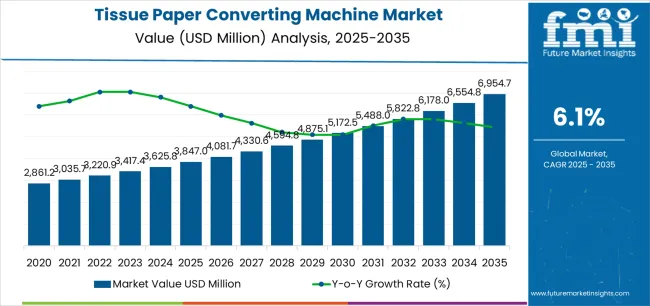
The tissue paper converting machine market demonstrates distinct growth phases with varying market characteristics and competitive dynamics. Between 2025 and 2030, the market progresses through its automation adoption phase, expanding from USD 3,847 million to USD 5,008 million with steady annual increments averaging 5.4% growth. This period showcases the transition from semi-automatic converting solutions to advanced systems with enhanced automation capabilities and integrated monitoring becoming mainstream features.
The 2025-2030 phase adds USD 1,161 million to market value, representing 38% of total decade expansion. Market maturation factors include standardization of automated converting protocols, declining equipment costs for advanced machinery, and increasing manufacturer awareness of converting machine benefits reaching 75-80% effectiveness in production applications. Competitive landscape evolution during this period features established manufacturers like Körber AG and PCMC expanding their equipment portfolios while new entrants focus on specialized applications and enhanced digital integration.
From 2030 to 2035, market dynamics shift toward intelligent automation and predictive maintenance deployment, with growth accelerating from USD 5,008 million to USD 6,954.7 million, adding USD 1,913 million or 62% of total expansion. This phase transition logic centers on universal smart converting systems, integration with Industry 4.0 platforms, and deployment across diverse manufacturing scenarios, becoming standard rather than specialized applications. The competitive environment matures with focus shifting from basic processing capability to comprehensive production optimization systems and integration with enterprise resource planning platforms.
At-a-Glance Metrics
| Metric | Value |
|---|---|
| Market Value (2025) | USD 3,847 million |
| Market Forecast (2035) | USD 6,921 million |
| Growth Rate | 6.10% CAGR |
| Leading Technology | Automatic Converting Machines |
| Primary Application | Household Tissue Segment |
The market demonstrates strong fundamentals with automatic converting systems capturing a dominant share through superior processing speed and reliable production capabilities. Household tissue applications drive primary demand, supported by increasing consumer spending on hygiene products and manufacturing efficiency management solutions. Geographic expansion remains concentrated in Asia-Pacific markets with rapid industrialization, while established economies show steady adoption rates driven by equipment modernization and capacity expansion programs.
Market expansion rests on three fundamental shifts driving adoption across hygiene manufacturing and paper processing sectors. 1. Hygiene awareness demand creates compelling competitive advantages through advanced converting machine systems that provide enhanced production efficiency with consistent product quality, enabling manufacturers to increase output capacity while maintaining cost competitiveness and meeting growing consumer demand. 2. Production automation accelerates as tissue manufacturers worldwide seek efficient processing systems that deliver high-speed converting with minimal labor requirements, enabling operational excellence that aligns with manufacturing modernization goals and profitability requirements. 3. Market consolidation drives adoption from large tissue producers requiring integrated converting solutions that maximize throughput while maintaining flexibility for multiple product formats during manufacturing and distribution operations.
However, growth faces headwinds from capital investment challenges that vary across manufacturer segments regarding equipment costs and facility integration requirements, potentially limiting deployment flexibility in small to medium-sized production facilities. Technical expertise considerations also persist regarding operator training and maintenance capabilities that may increase operational complexity in markets with limited skilled workforce availability.
The tissue paper converting machine market represents a compelling intersection of manufacturing automation, processing efficiency, and hygiene product demand. With robust growth projected from USD 3,847 million in 2025 to USD 6,921 million by 2035 at a 6.10% CAGR, this market is driven by increasing hygiene awareness, population growth, and demand for cost-effective production solutions.
The market's expansion reflects a fundamental shift in how tissue manufacturers approach production infrastructure. Strong growth opportunities exist across diverse applications, from household tissue operations requiring high-speed processing to commercial facilities demanding versatile converting capabilities. Geographic expansion is particularly pronounced in Asia-Pacific markets, led by China (7.4% CAGR) and India (7.1% CAGR), while established markets in North America and Europe drive automation and technology development.
The dominance of automatic converting systems and household tissue applications underscores the importance of proven processing technology and operational excellence in driving adoption. Equipment cost and technical complexity remain key challenges, creating opportunities for companies that can deliver advanced capabilities while maintaining investment efficiency.
Primary Classification: The market segments by product type into automatic converting machines, semi-automatic converting machines, and rewinder machines categories, representing the evolution from manual processing systems to advanced automated platforms for comprehensive tissue manufacturing operations.
Secondary Breakdown: Application segmentation divides the market into household tissue, commercial & industrial tissue, napkins & serviettes, facial tissue, and specialty tissue products sectors, reflecting distinct requirements for processing speed, product format integration, and quality standards.
Regional Classification: Geographic distribution covers North America, Europe, Asia Pacific, Latin America, and the Middle East & Africa, with Asia-Pacific markets leading growth while developed economies show steady expansion patterns driven by equipment modernization programs.
The segmentation structure reveals technology progression from semi-automatic converting systems toward integrated fully automated platforms with digital monitoring and predictive maintenance capabilities, while application diversity spans from household tissue operations to commercial facilities requiring versatile multi-format processing solutions.
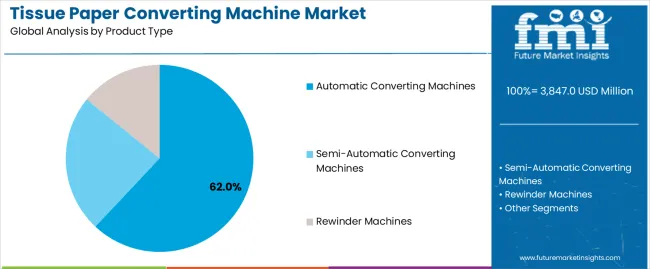
Automatic converting machine segment is estimated to account for 62% of the tissue paper converting machine market share in 2025. The segment's leading position stems from its fundamental role as a critical component in high-volume tissue manufacturing applications and its extensive use across multiple hygiene product sectors. Automatic converting machines' dominance is attributed to their superior processing speed, including integrated control systems, automated material handling, and quality monitoring capabilities that make them indispensable for large-scale production operations.
Market Position: Automatic converting systems command the leading position in the tissue paper converting machine market through advanced processing features, including comprehensive automation functions, production optimization, and reliable performance that enable manufacturers to deploy efficient manufacturing solutions across diverse production environments.
Value Drivers: The segment benefits from manufacturer preference for proven high-speed equipment that provides exceptional throughput without requiring extensive manual intervention. Reliable processing capabilities enable deployment in household tissue manufacturing, commercial product facilities, and industrial applications where efficiency and consistency represent critical operational requirements.
Competitive Advantages: Automatic converting systems differentiate through excellent production speed, proven operational reliability, and compatibility with modern manufacturing execution systems that enhance processing efficiency while maintaining cost-effective operational profiles suitable for diverse tissue manufacturing applications.
Key market characteristics:
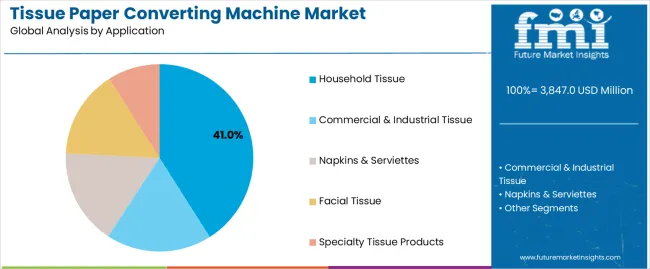
Household tissue segment is projected to hold 41% of the tissue paper converting machine market share in 2025. The segment's market leadership is driven by the extensive use of converting machines in toilet tissue production, kitchen towel manufacturing, and consumer tissue products, where equipment serves as the primary processing technology for retail distribution. The consumer hygiene industry's consistent investment in production capacity supports the segment's dominant position.
Market Context: Household tissue applications dominate the market due to widespread adoption of automated converting equipment and increasing focus on production efficiency management, cost optimization, and consistent quality applications that enhance manufacturing competitiveness while maintaining product standards.
Appeal Factors: Tissue manufacturers prioritize processing speed, equipment reliability, and integration with packaging systems that enable coordinated deployment across multiple production lines. The segment benefits from substantial volume demand and continuous production requirements that emphasize efficient converting for retail and distribution operations.
Growth Drivers: Capacity expansion programs incorporate advanced converting machines as standard equipment for household tissue production and consumer product facilities. At the same time, hygiene industry initiatives are increasing demand for efficient processing that complies with quality standards and enhances manufacturing productivity.
Market Challenges: Equipment investment requirements and production scale thresholds may limit deployment flexibility in smaller manufacturers or regional production scenarios.
Application dynamics include:
Growth Accelerators: Hygiene product demand drives primary adoption as tissue paper converting machine systems provide exceptional processing capabilities that enable production scale-up without excessive labor costs, supporting manufacturing efficiency and output volume that require consistent product quality. Population growth accelerates market expansion as emerging economies seek advanced converting solutions that maximize production capacity during industrialization while enhancing cost competitiveness through automated processing. Technology investment increases worldwide, creating sustained demand for modern converting systems that complement manufacturing modernization and provide competitive advantages in commodity tissue markets.
Growth Inhibitors: Capital cost challenges vary across manufacturer segments regarding equipment investments and installation requirements, which may limit market penetration and return timelines in smaller facilities with moderate production volumes. Technical complexity persists regarding equipment operation and maintenance expertise that may increase operational risks in applications with limited engineering support. Market competition across established manufacturers and regional equipment suppliers creates price pressure between different converting machine providers and existing production infrastructure.
Market Evolution Patterns: Adoption accelerates in Asia-Pacific and developing regions where hygiene product consumption justifies equipment investments, with geographic concentration in manufacturing hubs transitioning toward broader adoption in secondary markets driven by local production and import substitution programs. Technology development focuses on enhanced automation capabilities, improved energy efficiency, and integration with digital manufacturing platforms that optimize production monitoring and equipment utilization. The market could face disruption if alternative tissue production methods or revolutionary converting technologies significantly challenge conventional machine advantages in processing applications.
The tissue paper converting machine market demonstrates varied regional dynamics with Growth Leaders including China (7.4% CAGR) and India (7.1% CAGR) driving expansion through hygiene industry growth and manufacturing capacity development. Steady Performers encompass the USA (6.3% CAGR), Germany (5.5% CAGR), and Japan (5.1% CAGR), benefiting from established tissue sectors and equipment modernization adoption.
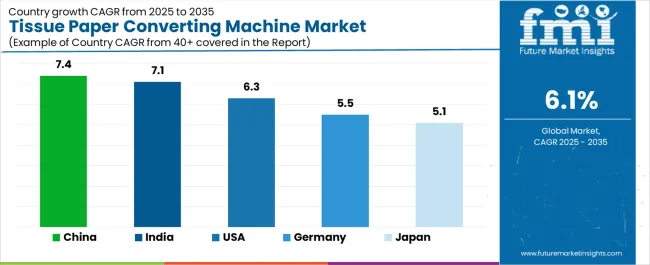
| Country | CAGR (2025-2035) |
|---|---|
| China | 7.4% |
| India | 7.1% |
| USA | 6.3% |
| Germany | 5.5% |
| Japan | 5.1% |
Regional synthesis reveals Asia-Pacific markets leading growth through industrial expansion and hygiene product consumption development, while European countries maintain steady expansion supported by manufacturing modernization and efficiency improvement requirements. North American markets show strong growth driven by capacity additions and automation investments.

China establishes regional leadership through explosive tissue manufacturing expansion and comprehensive production capacity development, integrating advanced tissue paper converting machine systems as standard components in household tissue and commercial product applications. The country's 7.4% CAGR through 2035 reflects government initiatives promoting domestic manufacturing and consumer goods production that mandate the use of modern converting systems in paper manufacturing operations. Growth concentrates in major industrial zones, including Guangdong, Zhejiang, and Shandong, where tissue production expansion showcases integrated automated converting systems that appeal to manufacturers seeking production efficiency and international quality standards.
Chinese manufacturers are developing cost-effective tissue paper converting machine solutions that combine local engineering expertise with imported technology integration, including high-speed processing systems and automated control capabilities.
Strategic Market Indicators:
The Indian market emphasizes organized sector growth, including rapid tissue manufacturing development and comprehensive production capacity expansion that increasingly incorporates tissue paper converting machines for commercial manufacturing and retail product applications. The country is projected to show a 7.1% CAGR through 2035, driven by massive middle-class expansion under economic development programs and commercial demand for efficient, reliable converting systems. Indian tissue facilities prioritize operational reliability with converting machines delivering consistent production through proven technology and cost-effective equipment capabilities.
Technology deployment channels include major tissue manufacturers, industrial equipment distributors, and government procurement programs that support domestic manufacturing for hygiene applications.
Performance Metrics:
The USA market emphasizes advanced tissue paper converting machine features, including innovative automation systems and integration with comprehensive production platforms that manage material handling, quality control, and manufacturing execution applications through unified equipment systems. The country is projected to show a 6.3% CAGR through 2035, driven by capacity modernization under efficiency improvement programs and commercial demand for reliable, high-speed converting systems. American tissue manufacturers prioritize production optimization with converting machines delivering exceptional throughput through advanced control technologies and integrated monitoring capabilities.
Technology deployment channels include major equipment suppliers, specialized tissue machinery providers, and manufacturer procurement programs that support custom configuration for large-scale production operations.
Performance Metrics:
In Bavaria, North Rhine-Westphalia, and Baden-Württemberg, German tissue manufacturers and paper processing facilities are implementing advanced tissue paper converting machine systems to enhance production capabilities and support efficiency optimization that aligns with manufacturing excellence requirements and quality protocols. The German market demonstrates sustained growth with a 5.5% CAGR through 2035, driven by industry modernization programs and equipment upgrade investments that emphasize advanced processing systems for household and commercial tissue applications. German tissue facilities are prioritizing converting machine systems that provide exceptional operational reliability while maintaining compliance with manufacturing standards and minimizing production inconsistencies, particularly important in premium tissue and specialty product operations.
Market expansion benefits from industry innovation programs that mandate modern equipment in manufacturing specifications, creating sustained demand across Germany's tissue and hygiene sectors, where processing efficiency and quality control represent critical requirements.
Strategic Market Indicators:
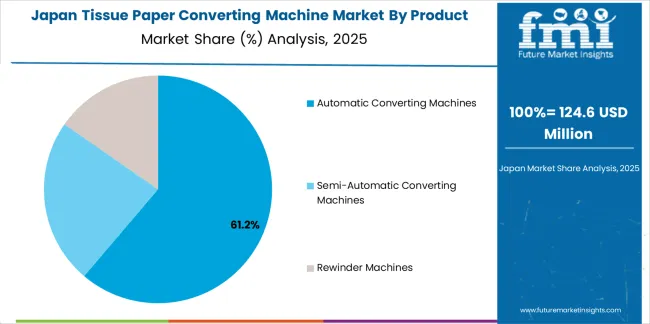
Japan's sophisticated tissue manufacturing market demonstrates meticulous converting machine deployment, growing at 5.1% CAGR, with documented operational excellence in household tissue production and commercial product applications through integration with existing manufacturing systems and quality assurance infrastructure. The country leverages engineering expertise in precision machinery and automated control to maintain market leadership. Manufacturing centers, including Shizuoka, Ehime, and Hokkaido, showcase advanced installations where converting machine systems integrate with comprehensive production platforms and inventory management systems to optimize manufacturing efficiency and product consistency.
Japanese tissue manufacturers prioritize equipment precision and processing reliability in machinery development, creating demand for advanced converting machine systems with superior features, including precise tension control and integration with automated quality inspection protocols. The market benefits from established manufacturing infrastructure and willingness to invest in premium converting technologies that provide superior production capability and operational consistency.
Market Intelligence Brief:
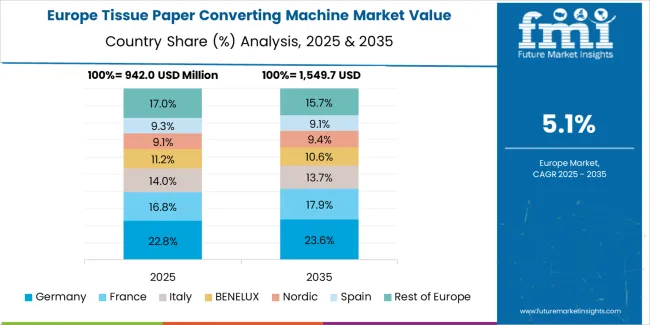
The tissue paper converting machine market in Europe is projected to grow from USD 1,154 million in 2025 to USD 1,921 million by 2035, registering a CAGR of 5.2% over the forecast period. Germany is expected to maintain its leadership position with a 38.2% market share in 2025, declining slightly to 37.8% by 2035, supported by its advanced manufacturing sector and major tissue production centers, including Bavaria and North Rhine-Westphalia.
Italy follows with a 24.6% share in 2025, projected to reach 25.1% by 2035, driven by comprehensive tissue manufacturing facilities and paper processing initiatives. The United Kingdom holds a 16.5% share in 2025, expected to maintain 16.8% by 2035 through established hygiene product sectors and equipment modernization adoption. France commands a 11.9% share, while Spain accounts for 7.2% in 2025. The Rest of Europe region is anticipated to gain momentum, expanding its collective share from 1.6% to 2.0% by 2035, attributed to increasing production capacity in Nordic countries and emerging Eastern European tissue manufacturing facilities implementing modern converting programs.
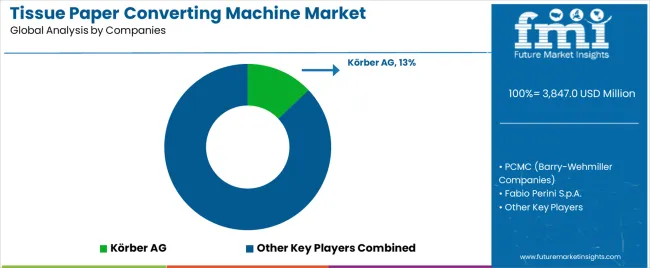
The Tissue Paper Converting Machine Market features approximately 10–15 players with moderate concentration, where the top three companies collectively hold around 40–48% of global market share through advanced manufacturing capabilities, high-efficiency production lines, and strong partnerships with major tissue paper manufacturers. The leading company, Körber AG, commands approximately 13% of the market share, supported by its extensive portfolio of converting technologies, automated tissue production lines, and global customer base. Competition focuses on machine speed, energy efficiency, customization for diverse tissue products, and technological integration rather than cost-driven differentiation.
Market leaders such as Körber AG, PCMC (Barry-Wehmiller Companies), and Fabio Perini S.p.A. maintain their competitive positions by offering cutting-edge converting equipment designed for high-speed, high-quality production of toilet paper, napkins, and facial tissues. These companies leverage advanced automation, digitalization, and high-performance engineering to provide tissue manufacturers with solutions that optimize production efficiency, reduce waste, and enhance product quality. Their ability to offer integrated solutions that connect machine performance with plant-wide process optimization continues to be a key differentiator.
Challenger groups such as Gambini S.p.A., Futura S.p.A., and A.Celli Paper S.p.A. compete by offering specialized tissue converting machinery focused on specific product segments, including ultra-soft tissues, embossed products, and sustainable packaging solutions. These companies emphasize customization options, flexibility in product design, and reduced energy consumption, gaining traction with manufacturers focused on niche tissue applications or operational efficiency.
Additional competitive pressure comes from regional players and specialized manufacturers, including Kawanoe Zoki Co., Ltd., Omet S.r.l., Chan Li Machinery Co., Ltd., and Dechangyu Paper Machinery Manufacture Co., Ltd. These firms focus on providing cost-effective and regionally tailored solutions for emerging markets, with strong service networks, fast delivery times, and the ability to meet local regulatory standards. Their competitive strengths lie in their ability to adapt machinery designs to the unique requirements of regional tissue producers, supporting both large-scale and small-scale production needs.
| Item | Value |
|---|---|
| Quantitative Units | USD 3,847 million |
| Product Type | Automatic Converting Machines, Semi-Automatic Converting Machines, Rewinder Machines |
| Application | Household Tissue, Commercial & Industrial Tissue, Napkins & Serviettes, Facial Tissue, Specialty Tissue Products |
| Regions Covered | North America, Europe, Asia Pacific, Latin America, Middle East & Africa |
| Countries Covered | USA, Germany, Japan, China, India, and 25+ additional countries |
| Key Companies Profiled | Körber AG, PCMC (Barry-Wehmiller Companies), Fabio Perini S.p.A., Gambini S.p.A., Futura S.p.A., A.Celli Paper S.p.A., Kawanoe Zoki Co., Ltd., Omet S.r.l., Chan Li Machinery Co., Ltd., Dechangyu Paper Machinery Manufacture Co., Ltd. |
| Additional Attributes | Dollar sales by product type and application categories, regional adoption trends across Asia Pacific, Europe, and North America, competitive landscape with machinery manufacturers and specialized suppliers, manufacturer preferences for automation and processing efficiency, integration with digital manufacturing platforms and quality control systems, innovations in converting technology and speed optimization, and development of energy-efficient solutions with enhanced productivity and reduced operational costs |
The global tissue paper converting machine market is estimated to be valued at USD 3,847.0 million in 2025.
The market size for the tissue paper converting machine market is projected to reach USD 6,954.7 million by 2035.
The tissue paper converting machine market is expected to grow at a 6.1% CAGR between 2025 and 2035.
The key product types in tissue paper converting machine market are automatic converting machines, semi-automatic converting machines and rewinder machines.
In terms of application, household tissue segment to command 41.0% share in the tissue paper converting machine market in 2025.






Our Research Products

The "Full Research Suite" delivers actionable market intel, deep dives on markets or technologies, so clients act faster, cut risk, and unlock growth.

The Leaderboard benchmarks and ranks top vendors, classifying them as Established Leaders, Leading Challengers, or Disruptors & Challengers.

Locates where complements amplify value and substitutes erode it, forecasting net impact by horizon

We deliver granular, decision-grade intel: market sizing, 5-year forecasts, pricing, adoption, usage, revenue, and operational KPIs—plus competitor tracking, regulation, and value chains—across 60 countries broadly.

Spot the shifts before they hit your P&L. We track inflection points, adoption curves, pricing moves, and ecosystem plays to show where demand is heading, why it is changing, and what to do next across high-growth markets and disruptive tech

Real-time reads of user behavior. We track shifting priorities, perceptions of today’s and next-gen services, and provider experience, then pace how fast tech moves from trial to adoption, blending buyer, consumer, and channel inputs with social signals (#WhySwitch, #UX).

Partner with our analyst team to build a custom report designed around your business priorities. From analysing market trends to assessing competitors or crafting bespoke datasets, we tailor insights to your needs.
Supplier Intelligence
Discovery & Profiling
Capacity & Footprint
Performance & Risk
Compliance & Governance
Commercial Readiness
Who Supplies Whom
Scorecards & Shortlists
Playbooks & Docs
Category Intelligence
Definition & Scope
Demand & Use Cases
Cost Drivers
Market Structure
Supply Chain Map
Trade & Policy
Operating Norms
Deliverables
Buyer Intelligence
Account Basics
Spend & Scope
Procurement Model
Vendor Requirements
Terms & Policies
Entry Strategy
Pain Points & Triggers
Outputs
Pricing Analysis
Benchmarks
Trends
Should-Cost
Indexation
Landed Cost
Commercial Terms
Deliverables
Brand Analysis
Positioning & Value Prop
Share & Presence
Customer Evidence
Go-to-Market
Digital & Reputation
Compliance & Trust
KPIs & Gaps
Outputs
Full Research Suite comprises of:
Market outlook & trends analysis
Interviews & case studies
Strategic recommendations
Vendor profiles & capabilities analysis
5-year forecasts
8 regions and 60+ country-level data splits
Market segment data splits
12 months of continuous data updates
DELIVERED AS:
PDF EXCEL ONLINE
Market Leaders & Share in the Tissue Paper Converting Machine Industry
Tissue Paper Converting Machine Market Trends – Growth, Demand & Forecast 2025-2035
Tissue Paper Embosser Machine Market Size and Share Forecast Outlook 2025 to 2035
Tissue Paper Unwinding Machine Market Size and Share Forecast Outlook 2025 to 2035
Competitive Overview of Tissue Paper Unwinding Machine Manufacturers
Paper Napkins Converting Machines Market Size and Share Forecast Outlook 2025 to 2035
Paper Machine Systems Market
Paper Cup Machine Market Size and Share Forecast Outlook 2025 to 2035
Competitive Overview of Paper Cup Machine Market Share
Paper Napkin Converting Lines Market Size and Share Forecast Outlook 2025 to 2035
Paper Making Machines Market
Paper Loading Machine Market Trend Analysis Based on Product, End-Use, Loading Mechanism, Machine Size/Capacity, Automation Level and Regions 2025 to 2035
Machine Glazed Paper Market Size and Share Forecast Outlook 2025 to 2035
Machine Glazed Paper Industry Analysis in Asia Pacific Forecast Outlook 2025 to 2035
Machine Glazed Paper Industry Analysis in Western Europe Size and Share Forecast Outlook 2025 to 2035
Machine Glazed Paper Industry Analysis in Korea Size and Share Forecast Outlook 2025 to 2035
Machine Glazed Paper Industry Analysis in Japan Size and Share Forecast Outlook 2025 to 2035
Key Players & Market Share in Machine Glazed Paper Industry
Kraft Paper Machine Market Analysis - Size, Share, and Forecast Outlook 2025 to 2035
Paper Core Cutting Machine Market Size and Share Forecast Outlook 2025 to 2035

Thank you!
You will receive an email from our Business Development Manager. Please be sure to check your SPAM/JUNK folder too.
Chat With
MaRIA